Hitachi C 10FR User Manual
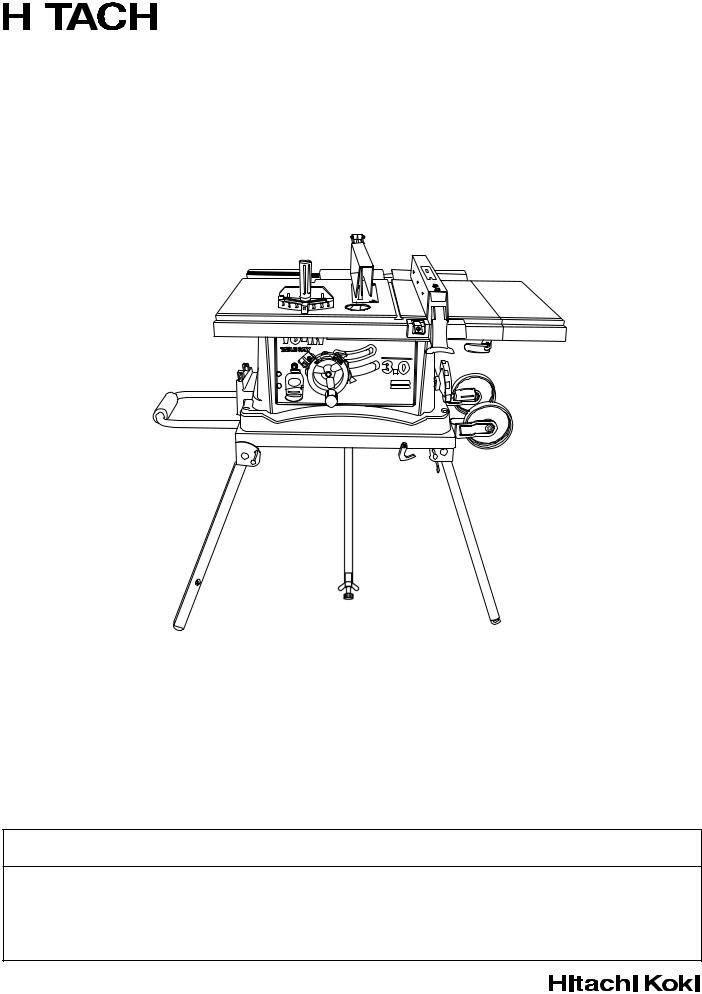
|
|
|
|
|
|
|
|
|
|
|
|
Model |
|
C 10FR |
Jobsite Table Saw |
||
|
|
|
|
|
|
INSTRUCTION MANUAL AND SAFETY INSTRUCTIONS
 WARNING
WARNING
Improper and unsafe use of this power tool can result in death or serious bodily injury!
This manual contains important information about product safety. Please read and understand this manual before operating the power tool. Please keep this manual available for others before they use the power tool.

CONTENTS
SECTION |
PAGE |
SECTION |
PAGE |
Product Specifications ............................................................ |
3 |
Know Your Table Saw ............................................................ |
9 |
Power Tool Safety ................................................................... |
4 |
Assembly and Adjustments ................................................. |
10 |
Table Saw Safety .................................................................... |
5 |
Operation ............................................................................... |
17 |
Electrical Requirements and Safety ...................................... |
6 |
Maintenance .......................................................................... |
21 |
Accessories and Attachments ............................................... |
7 |
Troubleshooting Guide ......................................................... |
22 |
Tools Needed For Assembly .................................................. |
7 |
Push Stick Pattern ................................................................. |
23 |
Carton Contents ..................................................................... |
7 |
Parts List ................................................................................ |
24 |
HITACHI AUTHORIZED SERVICE CENTERS
Service under this warranty is available from Hitachi Koki U.S.A., Ltd. at :
IN THE U.S.A. |
IN CANADA |
3950 Steve Reynolds Blvd. Norcross, GA 30093
9409 Owensmouth Ave. Chatsworth, CA 91311
OR CALL: (800) 546-1666 for a service center nearest you.
6395 Kestrel Road Mississauga, ON L5T 1Z5
OR CALL: (800) 970-2299 for a service center nearest you.
— 2 —
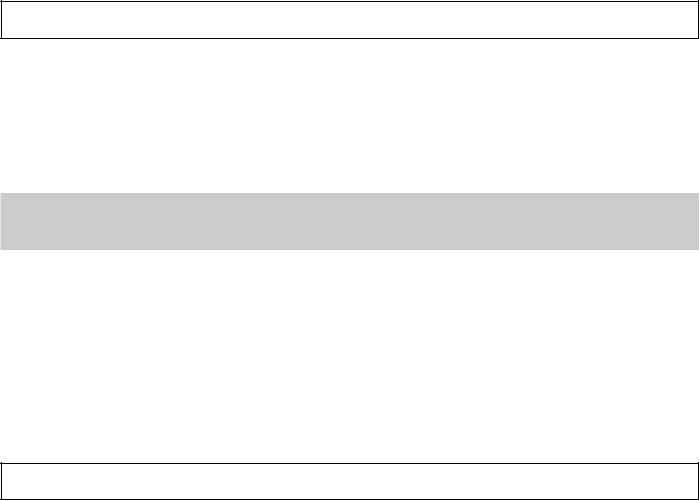
 WARNING
WARNING
Some dust created by power sanding, sawing, grinding, drilling and other construction activities contains chemicals known to the state of California to cause cancer, birth defects or other reproductive harm. Some examples of these chemicals are:
•Lead from lead-based paints
•Crystalline silica from bricks, cement and other masonry products
•Arsenic and chromium from chemically treated lumber
Your risk from these exposures varies, depending on how often you do this type of work. To reduce your exposure to these chemicals, work in a well-ventilated area and work with approved safety equipment such as dust masks that are specially designed to filter out microscopic particles.
PRODUCT SPECIFICATIONS
MOTOR |
|
SAW |
|
HP (Maximum developed) ............ |
3.0 |
Table Size ....................................... |
26-1/16” x 19-21/64” |
Type ................................................ |
Universal |
Table Extensions ........................... |
2- Right, Rear |
Amps .............................................. |
15 |
Extension Fence Capacity ............. |
24” Right |
Voltage ........................................... |
120 |
Blade Size....................................... |
10” |
Hz .................................................... |
60 |
Rip Scale ........................................ |
YES |
RPM (no load) ................................ |
5000 |
Rip Fence........................................ |
YES |
Overload Protection ...................... |
YES |
Miter Gauge ................................... |
YES |
|
|
Maximum Cut Depth @ 90° .......... |
3-1/8” |
|
|
Maximum Cut Depth @ 45° .......... |
2-1/2” |
|
|
Net Weight ..................................... |
64.5 LBS |
 WARNING
WARNING
To avoid electrical hazards, fire hazards or damage to the table saw, use proper circuit protection.
This table saw is wired at the factory for 110-120 Volt operation. It must be connected to a 110-120 Volt / 15 Ampere time delay fuse or circuit breaker. To avoid shock or fire, replace power cord immediately if it is worn, cut or damaged in any way.
Before using your table saw, it is critical that you read and understand these safety rules. Failure to follow these rules could result in serious injury to you or damage to the table saw.
— 3 —

POWER TOOL SAFETY
 WARNING
WARNING
Before using your table saw, it is critical that you read and understand these safety rules. Failure to follow these rules could result in serious injury or damage to the table saw.
Good safety practices are a combination of common sense, staying alert and understanding how to use your power tool. To avoid mistakes that could cause serious injury, do not plug in your power tool until you have read and understood the following safety rules:
1.READ and become familiar with this entire Operator’s Manual. LEARN the tool’s applications, limitations and possible hazards.
2. WARNING
WARNING
Look for this symbol that identifies important safety precautions. It means CAUTION! BECOME ALERT! YOUR SAFETY IS INVOLVED!
3.NEVER OPERATE THIS MACHINE WITHOUT THE SAFETY GUARD IN PLACE FOR ALL THROUGH SAWING OPERATIONS.
4.DO NOT USE IN A DANGEROUS ENVIRONMENT such as damp or wet locations or exposure to rain. Keep work area well lighted.
5.DO NOT use power tools in the presence of flammable liquids or gases.
6.KEEP WORK AREA CLEAN. Cluttered areas and benches invite accidents.
7.KEEP CHILDREN AWAY. All visitors should be kept at a safe distance from the work area.
8.DO NOT FORCE THE TOOL. It will do the job better and safer at the rate for which it was designed.
9.USE THE RIGHT TOOL. Don’t force the tool or attachment to do a job for which it is not designed.
10.WEAR PROPER APPAREL. DO NOT wear loose clothing, gloves, neckties, rings, bracelets or other jewelry that may get caught in moving parts. Non-slip footwear is recommended. Wear protective hair covering to contain long hair.
11.WEAR A FACE MASK OR DUST MASK. Sawing, cutting and sanding operations produce dust.
12.DISCONNECT TOOLS before servicing and when changing accessories such as blades, cutters, etc.
13.REDUCE THE RISK OF UNINTENTIONAL STARTING. Make sure the switch is in the OFF position before plugging into the power supply.
14.USE ONLY RECOMMENDED ACCESSORIES. Consult the Operator’s Manual for recommended accessories. The use of improper accessories may cause injury to you or damage to the tool.
15.REMOVE ADJUSTING KEYS AND WRENCHES. Form the habit of checking to see that keys and
adjusting wrenches are removed from the tool before turning ON.
16.NEVER LEAVE TOOL RUNNING UNATTENDED. TURN THE POWER “OFF”. Do not leave the tool before it comes to a complete stop.
17.NEVER STAND ON TOOL. Serious injury could occur if the tool is tipped or if the cutting tool is unintentionally contacted.
18.DO NOT OVERREACH. Keep proper footing and balance at all times.
19.MAINTAIN TOOLS WITH CARE. Keep tools sharp and clean for most efficient and safest performance. Follow instructions for lubricating and changing accessories.
20.CHECK FOR DAMAGED OR LOOSE PARTS.
Before further use of the tool, a guard or other part that is damaged should be carefully checked to ensure it will operate properly and perform its intended function. Check for alignment of moving parts, binding of moving parts, loose mounting and any other conditions that may affect its safe operation. A guard or other part that is loose or damaged should be properly adjusted repaired or replaced.
21.MAKE WORKSHOP CHILD PROOF with padlocks, master switches or by removing starter keys.
22.DO NOT operate the tool if you are under the influence of any drugs, alcohol or medication that could impair your ability to use the tool safely.
23.USE DUST COLLECTION SYSTEM wherever possible. Dust generated from certain materials can be hazardous to your health and in some cases, a fire hazard. Always operate the power tool in a wellventilated area with adequate dust removal.
24.ALWAYS WEAR EYE PROTECTION. Any power tool can throw foreign objects into your eyes that could cause permanent eye damage. ALWAYS wear safety goggles (not glasses) that comply with ANSI safety standard Z87.1. Everyday glasses have only impact resistant lenses. They ARE NOT safety glasses. NOTE: Glasses or goggles not in compliance with ANSI Z87.1 could cause serious injury when they break.
25.DIRECTION OF FEED. Feed work into a blade or cutter against the direction of rotation of the blade or cutter only.
— 4 —

TABLE SAW SAFETY
1.ALWAYS USE SAW BLADE GUARD, splitter and antikickback pawls for every operation for which they can be used, including through sawing. Through sawing operations are those in which the blade cuts completely through the workpiece when ripping or crosscutting.
2.ALWAYS HOLD WORK FIRMLY against the miter gauge or rip fence.
3.USE A PUSH STICK when required. Always use a push stick especially when ripping narrow stock. Refer to ripping instructions in this Operator’s Manual where the push stick is covered in detail. A pattern for making your own push stick is included on page 23.
4.NEVER PERFORM ANY OPERATION FREE HAND, which means using only your hands to support or guide the workpiece. Always use either the fence or the miter gauge to position and guide the work. WARNING: FREEHAND CUTTING IS THE MAJOR CAUSE OF KICK-BACK & FINGER/HAND AMPUTATIONS.
5.NEVER STAND or have any part of your body in line with the path of the saw blade. Keep your hands out of the saw blade path.
6.NEVER REACH behind or over the cutting tool for any reason.
7.REMOVE the rip fence when crosscutting.
8.DO NOT USE a molding head with this saw.
9.FEED WORK INTO THE BLADE against the direction of rotation only.
10.NEVER use the rip fence as a cut-off gauge when crosscutting.
11.NEVER ATTEMPT TO FREE A STALLED SAW BLADE without first turning the saw OFF. Turn power switch OFF immediately to prevent motor damage.
12.PROVIDE ADEQUATE SUPPORT to the rear and the sides of the saw table for long or wide workpieces.
13.AVOID KICKBACKS (work thrown back towards you) by keeping the blade sharp, the rip fence parallel to the saw blade and by keeping the splitter, antikickback pawls and guards in place, aligned and functioning. Do not release work before it has passed all the way past the saw blade. Do not rip work that is twisted, warped or does not have a straight edge to guide it along the fence.
14.AVOID AWKWARD OPERATIONS and hand positions where a sudden slip could cause your hand to move into the saw blade.
15.NEVER USE SOLVENTS to clean plastic parts. Solvents could possibly dissolve or otherwise damage the material. Only a soft damp cloth should be used to clean plastic parts.
16.MOUNT your table saw on a bench or stand before performing any cutting operations. Refer to ASSEMBLY AND ADJUSTMENTS on page 10.
17.NEVER CUT METALS or materials which may make hazardous dust.
18.ALWAYS USE IN WELL-VENTILATED AREA. Remove sawdust frequently. Clean out sawdust from the interior of the saw to prevent a potential fire hazard. Attach a vacuum to the dust port for additional sawdust removal.
19.NEVER LEAVE THE SAW RUNNING UNATTENDED. Do not leave the saw until it comes to a complete stop.
20.For proper operation follow the instructions in this Operator’s Manual entitled ASSEMBLY AND ADJUSTMENTS (Page 10). Failure to provide sawdust fall-through and removal hole will allow sawdust to build up in the motor area resulting in a fire hazard and potential motor damage.
— 5 —

ELECTRICAL REQUIREMENTS AND SAFETY
POWER SUPPLY REQUIREMENTS
 WARNING
WARNING
To avoid electrical hazards, fire hazards or damage to the table saw, use proper circuit protection. Always use a separate electrical circuit for your tools. This power tool is wired at the factory for 120V operation. Connect it to a 120V, 15 Amp circuit and use a 15 Amp time delay fuse or circuit breaker. To avoid shock or fire, replace the cord immediately if it is worn, cut or damaged in any way.
EXTENSION REQUIREMENTS
 WARNING
WARNING
Any extension cord must be GROUNDED for safe operation.
MINIMUM GAUGE FOR EXTENSION CORDS (AWG type / 120 Volt only)
Ampere Rating |
|
Total length in feet |
|
||||
|
|
|
|
|
|
|
|
|
Not |
|
|
|
|
|
|
More Than |
More Than |
25’ |
|
50’ |
100’ |
|
150’ |
0 |
6 |
18 |
|
16 |
16 |
|
14 |
6 |
10 |
18 |
|
16 |
14 |
|
12 |
10 |
12 |
16 |
|
16 |
14 |
|
12 |
12 |
16 |
14 |
|
12 |
Not Applicable |
||
GUIDELINES FOR EXTENSION CORDS
Any extension cord used for power tools MUST be grounded (3-wire with two flat prongs and one round ground prong).
Make sure the extension cord is in good condition. When using an extension cord, make sure you use one heavy enough to carry the current the tool will draw. An undersized cord will cause a drop in line voltage resulting in loss of power and overheating. The table above shows the correct size to use according to extension cord length and nameplate ampere rating. If in doubt, use the next heavier gauge cord. The smaller the gauge number the heavier the cord.
NOTE: The 12 to 16 Amp rating is correct for this tool. It is highlighted in the table above.
Be sure your extension cord is properly wired and in good condition. Always replace a damaged extension cord or have it repaired by a qualified person before using it. Protect your extension cords from sharp objects, excessive heat and damp or wet areas.
Before connecting the saw to the extension cord, make sure the saw switch is turned OFF.
GROUNDING INSTRUCTIONS
IN THE EVENT OF A MALFUNCTION OR BREAKDOWN, grounding provides a path of least resistance for electric current and reduces the risk of electric shock. This saw is equipped with an electric cord that has an equipment grounding conductor and a grounding plug. The plug MUST be plugged into a matching receptacle that is properly installed and grounded in accordance with ALL local codes and ordinances.
DO NOT MODIFY THE PLUG PROVIDED. If it will not fit the receptacle, have the proper receptacle installed by a qualified electrician.
IMPROPER CONNECTION of the equipment grounding conductor can result in risk of electric shock. The conductor (wire) with the green insulation (with or without yellow stripes) is the equipment grounding conductor. If repair or replacement of the electric cord or plug is necessary, DO NOT connect the equipment grounding conductor to a live terminal.
CHECK with a qualified electrician or service personnel if you do not completely understand the grounding instructions, or if you are not sure the saw is properly grounded.
Use only 3-wire extension cords that have 3-prong grounding plugs and 3-pole grounding receptacles that accept the saw’s plug. Repair or replace damaged or worn cords immediately.
3-Prong Plug
Grounding Prong
Properly Grounded
3-Prong Receptacle
Grounding Lug
Make Sure This is Connected to a Known Ground
2-Prong
Receptacle
Adapter
— 6 —
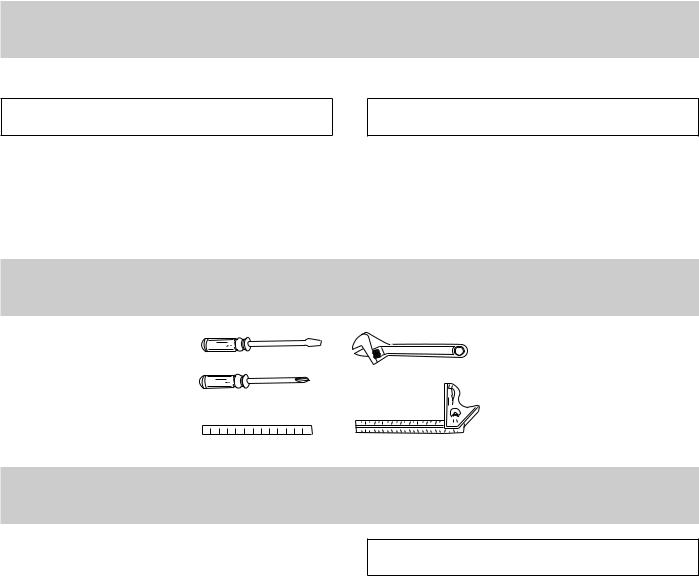
ACCESSORIES AND ATTACHMENTS
RECOMMENDED ACCESSORIES
 WARNING
WARNING
Visit your Hardware Department or see the Power and Hand Tools Catalog to purchase recommended accessories for this power tool
 WARNING
WARNING
To avoid the risk of personal injury:
Do not use adjustable (wobble) type dadoes or carbide tipped dado blades; maximum dado width is 1/2" .
Do not use a dado with a diameter larger than 6" .
Do not use molding head set with this saw.
Do not modify this power tool or use accessories not recommended by Store.
TOOLS NEEDED FOR ASSEMBLY
TOOLS NEEDED
Medium screwdriver
Adjustable wrench
#2 Philips screwdriver
Straight edge |
Combination square |
CARTON CONTENTS
UNPACKING AND CHECKING CONTENTS
Separate all parts from packing materials. Check each part with the illustration on the next page and the "Table of Loose Parts" to make certain all items are accounted for, before discarding any packing material.
TABLE OF LOOSE PARTS
ITEM |
DESCRIPTION |
QUANTITY |
A. |
Table saw assembly |
1 |
B. |
Blade |
1 |
C. |
Blade wrenches |
2 |
D. |
Miter gauge |
1 |
E. |
Hex key |
1 |
F. |
Bolt, flat washer, toothed washer, 1 each |
|
|
Oval washer, spring washer |
|
G. |
Blade guard and splitter |
1 |
H. |
Rip fence |
1 |
I. |
Rear table extension |
1 |
J. |
Rear table extension tube |
2 |
K. |
Location seat |
4 |
L. |
Dome nuts |
2 |
M. |
Hand wheels |
2 |
N. |
Table extension |
1 |
O. |
Dust collect elbow |
1 |
P. |
Parallel washer hardware |
1 each |
 WARNING
WARNING
If any part is missing or damaged, do not attempt to assemble the table saw, plug in the power cord, or turn the switch ON until the missing or damaged part is obtained and is installed correctly.
STAND: |
|
|
Q. |
Stand assembly |
1 |
R. |
Hex. head bolts |
4 |
S. |
Flat washers |
4 |
T. |
Roller wheels |
2 |
U. |
Square neck bolts |
2 |
V. |
Nuts |
2 |
W. |
Support rod |
1 |
X. |
Batteries |
2 |
NOTE: To make assembly easier, keep contents of box together. Apply a coat of automobile wax to the table. Wipe all parts thoroughly with a clean dry cloth. This will reduce friction when pushing the workpiece. To avoid injury, the styrofoam block should be removed between the motor and the table.
— 7 —
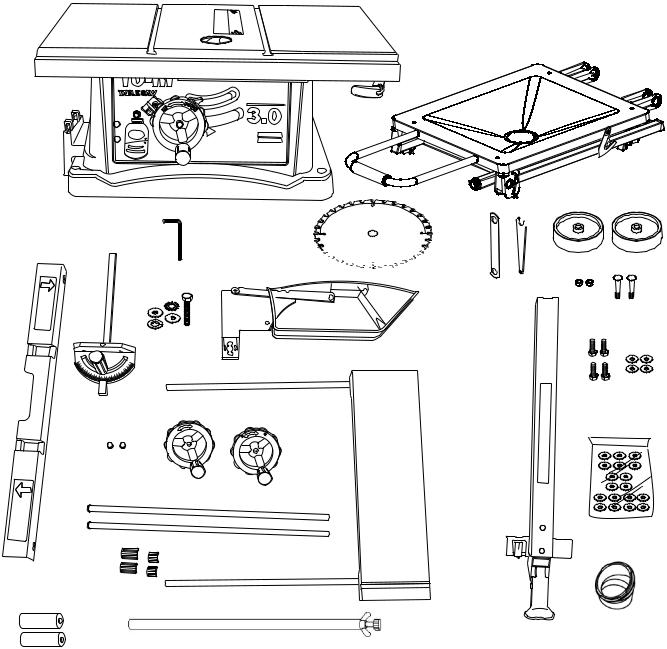
UNPACKING YOUR TABLE SAW
E
F
4 |
|
|
|
30 |
30 |
|
|
|
|
5 |
|
|
|
45 |
60 |
75 |
90 |
75 |
60 |
|
|
D
UP
L
I K
X
A
DOWN
M
J
O
Q












 B
B  T
T
C
V U
G
R S
45
P
N
W H O
— 8 —
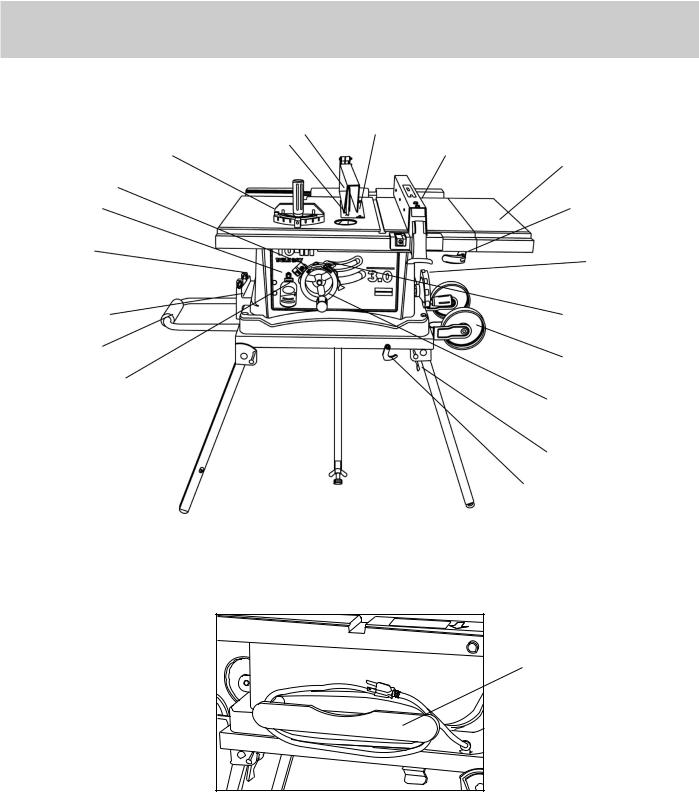
KNOW YOUR TABLE SAW
The Front of Table Saw
Blade guard with LED lighting |
Table Insert |
|
Miter gauge |
Cutting line |
Rip fence |
Bevel angle |
indicator |
Side table extension |
|
||
|
|
|
Pointer & scale |
|
Extension wing |
Overload reset |
|
|
|
locking lever |
|
switch |
|
|
|
|
|
Miter gauge |
|
|
storage |
|
Blade tilting |
|
|
|
|
|
handwheel |
Fence storage |
|
Blade bevel |
|
lock knob |
|
|
|
|
Stand handle |
|
Stand wheel |
|
|
|
ON/OFF switch |
|
|
with key |
|
Blade elevation |
|
|
handwheel |
|
Lock lever |
Support Rod |
Stand hook |
|
The Rear of Table Saw
Cord wrap
— 9 —
